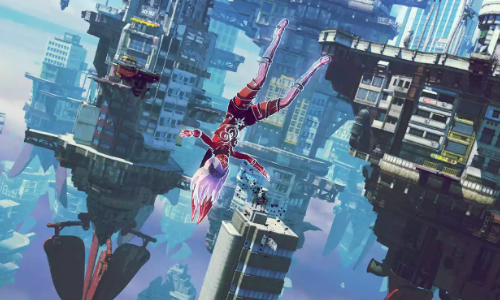Review: Gravity Rush 2

Part of the joy of video games is that they can offer a level of control that’s so often lacking from real life. They allow you to take your fate in your own two hands – a cool head and nimble fingers will decide whether you dodge a blow in Dark Souls, pull off an outrageous feint in FIFA, or make Mario leap the extra hair’s breadth that separates life from death.
Gravity Rush takes the opposite tack, sacrificing precision and finesse for the thrill of the unpredictable. Your character, Kat, can manipulate gravity, able to decide which way is “down”, allowing her to tumble gracelessly through the sky in any direction, the world tilting and lurching around her. This isn’t flying, it’s falling sideways through crowded cities, crashing through crates and knocking off chimney pots.
The first Gravity Rush was released for the PlayStation Vita in 2012, and has become a cult favourite almost despite itself. It was lauded for its beautiful, anime art-style, open world gameplay and free-flowing mechanics (despite its insistence on showing off the Vita’s unwieldy motion controls), but its storytelling was obtuse to the point of senselessness. It asked interesting questions about the nature of time that it was either unable or unwilling to answer; it didn’t leave things on a cliff-edge – it walked away mid-sentence.
Five years later, Gravity Rush 2 is both a realisation of the first game’s potential and a doubling down on its flaws.
On the Vita, Kat was always straining to escape from the prison of her tiny screen, and the panoramic quality of the PS4 sequel looks glorious, with the floating islands that make up Kat’s world bringing to mind a Studio Ghibli animation. Every frame is filled with rare and unexpected beauty, from burnt orange sunsets fading behind dizzying skyscrapers to circular rainbows ringing the horizon.
Kat is a wonderful heroine and her joyful tumbling is the perfect way to traverse this world. Every street is thronged with passers-by who flee in terror whenever she comes crashing into their lives, cracking paving slabs as she thuds to the ground. This apparently bustling world does, however, flatter to deceive. Unlike the densely textured world of, say, Arkane’s Dishonored games, Gravity Rush 2 is all surface: nothing but inaccessible, empty polygons lie behind the brightly lit windows and grand facades.
Combat has been tightened, with two new gravity “styles” – very heavy and very light – adding variety without overly complicating things. Kat’s ability to whisk piles of debris into the air and launch them at her enemies feels more intuitive than before, although her main attack, shifting gravity to fall feet first towards her foes, is still prone to sending her hurtling away from the action.
Things go a little awry, once again, when it comes to the narrative. Some designers would have used the sequel to clean up the mess left in the wake of the first game; not Keiichiro Toyama (the wunderkind who created the first Silent Hill when he was just 21). Not only do you need to have played the original Gravity Rush to have any hope of understanding the plot, you also need to have watched the two-part anime movie released at the end of last year. And even then, best of luck.
Toyama pays little heed to the prevailing wisdom of game design. His sequel is packed with anachronistic mini games and collectibles. Much of Kat’s time is spent completing repetitive tasks that feel like chores during the first attempt and drive you to distraction by the 20th. Most of the dialogue, presented as neat interactive comic strips, exists only for exposition. And there are far too many inexplicable, tedious stealth missions that have no place in a game where the protagonist cannot slow her pace beyond a brisk jog.
The main story is divided into three chapters, the first of which sees Kat fighting against social inequality in a land where the working classes live in shanty towns literally beneath the rich folk in their gleaming sky-mansions. The second chapter picks up where the original Gravity Rush left off, and the final section delves into Kat’s mysterious past, where the game’s most unforgivably dull and protracted sequences take place.
All three are really just excuses to pack in lots of increasingly overblown and oversized bosses, many of whom come with giant glowing weak spots, as if it were still 1995. The second half of the game is made up of one climactic fight after another, with the narrative importance of each lost amid the ceaseless torrent of action. In one mid-way mission, for instance, an entire city comes to life, is destroyed, and is never spoken of again. Some of these fights are fun, while others are a maddening and seemingly endless battle against the game’s unpredictable mechanics.
But to get bogged down in these frustrations is to miss the point. The joy is in the little things: taking a young boy on a flying tour of the city to recreate his grandfather’s photographs; chasing after a seagull that’s stolen your lunch; handing out flyers for a local food wagon.
Kat is never more fun than when she’s hurtling horizontally across the sky for no reason other than to feel the wind against her face. At its best, Gravity Rush 2 recreates the sense of reckless abandon that came when riding a bike as a child, the feeling of limitless potential combined with the intoxicating thrill of knowing that the tarmac could come up to meet you at any moment.

